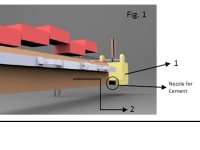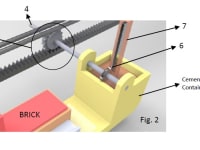Having seen construction labourers slog for hours to construct brick walls and trying very hard all the time to maintain proper alignment of the bricks, we have come up with a novel machine to make this process faster and a lot more efficient.
In the existing method, an approximate amount of cement is laid manually and a brick is then placed on top of it. It is then tapped with a shovel to maintain a constant horizontal level. It requires three labourers: one for carrying the cement to the site, one for carrying the bricks and another one for doing the actual construction work. Major limitations of this system are as follows:
1. Manual application of cement and placement of bricks makes the entire process very time consuming
2. The accuracy is reduced due to manual error and human limitations.
3. Maintaining the accuracy and speed requires skilled and experienced labourers
4. Faster construction of walls necessitates more man power
5. A lot of cement gets wasted by inexperienced labour
The proposed machine intends to improve the present method by mechanizing most of the tasks that require skill and time. It is comprised of a cement layer (item no. 1 in Fig. 1), followed by a brick layer (2), followed by a roller (3). The operator pushes the whole system horizontally by means of a handle (4), which is supported by a hydraulic jack (not shown in the figure). The hydraulic jack is also used to raise the entire setup to lay subsequent layers of bricks. Linear movement imparted by the operator is converted to rotational motion by a rack and pinion system (5) which is again converted to vertical linear motion using another pinion-rack system (6), which in turn powers a piston (7) fitted into the cement container. The piston pushes the cement out of the container through an opening whose size can be adjusted to give different thicknesses for the cement layer. Once a layer of cement has been laid, the brick layer (2), which contains slots and guide ways so as to hold several bricks at once in proper alignment, is used to place the bricks on top of the cement layer. This is followed by compression of the bricks by a roller (3) attached to the brick layer so that a uniform horizontal level is maintained.
Thus the following improvements have been achieved:
- Reduced workforce: this machine requires one, or at most two operator(s)
- The thickness of cement being laid can be adjusted easily to suit the situational needs
- Improved accuracy: each layer of bricks is maintained at a horizontal level by a roller the lateral alignment is maintained by guide ways
- Faster construction and better accuracy: most of the work is mechanized
- Minimized wastage of cement and other resources
- The skill required to operate this system is minimal, and can be easily acquired. Hence, a lot of experience is not required.
Parts are numbered in the attached pictures.
Voting
-
ABOUT THE ENTRANT
- Name:Ankit Agarwal
- Type of entry:teamTeam members:Ankit Agarwal
Amogh Amladi
Aarjav Malhotra - Software used for this entry:Solidworks, Keyshot
- Patent status:none





